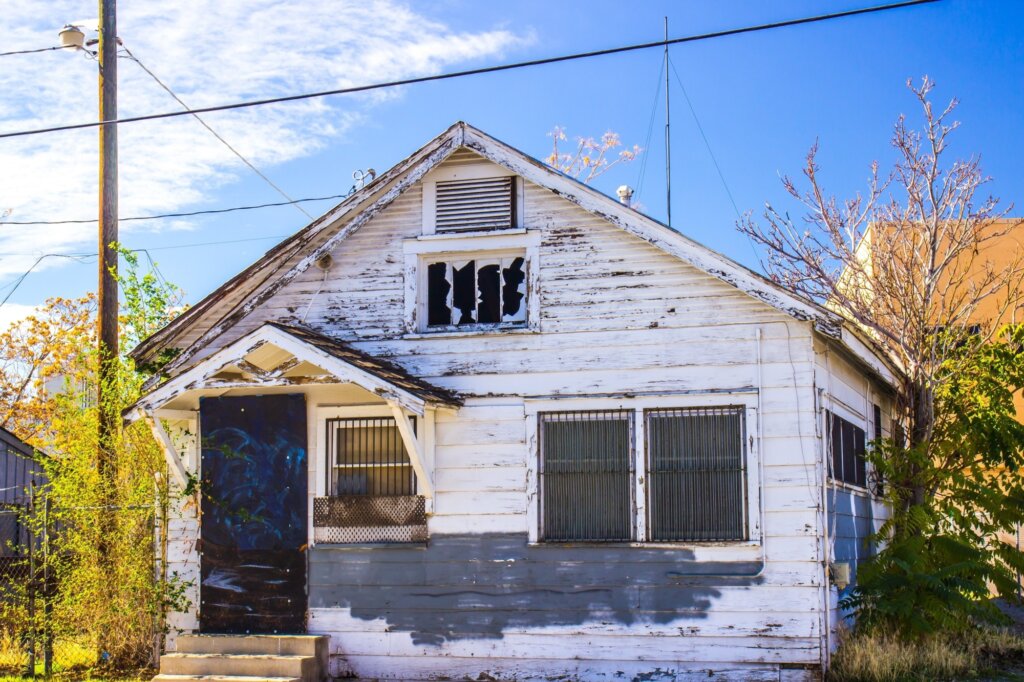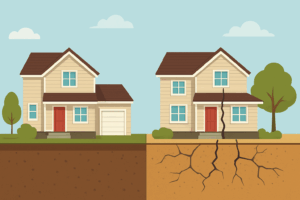
It’s difficult to say where foreclosure proceedings sit in the economic landscape of the United States right now. The COVID-19 pandemic changed a lot of things. While foreclosure starts increased, foreclosure sales decreased, according to the Federal Housing Finance Agency.
Trends can change. Nevertheless, homes will still become distressed, and dealing with distressed real estate will remain a necessary fact of the housing market.
Have you ended up the owner of a distressed property? Has the bank started the foreclosure process? Do you have any plans for how to keep going or move on?
We’ll tell you how to keep going. In this article, we’ll outline what a distressed property is, how to sell it, and how to change your situation.
In Today’s Article
- What Is a Distressed Property?
- Homes That Might Count as Distressed Properties
- What to Do If Your Home Becomes a Distressed Home
- Should You Repair First?
- How to Speed Up the Process
What Is a Distressed Property?

Distressed properties comprise homes approaching foreclosure proceedings, homes for which foreclosure has already started, and homes that have already been repossessed by the bank. We’ll start by going over the many ways a home can become distressed.
Missing Payments
While one or two missed mortgage payments won’t instantly send a home into foreclosure, a homeowner who can’t pay their monthly mortgage payments will find the home becoming distressed if it becomes a pattern. Once the homeowner’s delinquent mortgage payments violate the terms of the mortgage, the property enters pre-foreclosure.
During pre-foreclosure, the bank informs the homeowner that it would like to start foreclosure proceedings. At this stage, the homeowner can still negotiate alternative terms. Depending on the circumstances, it may still work out for the best to sell the distressed house or allow the bank to take it back.
Foreclosure/Bank Owned Property/REO
Foreclosure happens when a homeowner cannot make payments on a home and the creditor cannot come to another arrangement with the homeowner. During foreclosure proceedings, the lender takes possession of the property. Sometimes the lender will accept a deed-in-lieu arrangement, in which the lender takes possession of the home without going through foreclosure proceedings.
Once the bank takes possession of the home, the property becomes a “Real Estate Owned” (REO) property. At this point in the process, the current property owners or homeowners go through eviction proceedings. The bank will then sell the property.
Homes That Might Count as Distressed Properties

Not everyone agrees about the definition of a distressed property. Depending on who you talk to, these types of homes might also fall into the category of “distressed property,” and the issues that affect the sale process will often prove similar.
Government Home Sales
While most distressed properties fall under the purview of private lenders or homeowners, the government also ends up involved in some cases. The Federal Housing Administration (FHA) insures some mortgages, and in the event that such a mortgage falls through, the government forecloses on the home.
Other than the creditor, these homes follow the same process as other distressed real estate properties.
Bankruptcy or Divorce Settlements
Sometimes, homeowners need to part ways with a home as a result of bankruptcy or a divorce. During some divorces, homeowners cannot come to terms about the ownership of the marital home. Bankruptcy may require the sale of a home to pay back creditors.
Just as with conventional distressed homes, these homes need to sell fast. The process for the seller will resemble that of a home in pre-foreclosure.
Physically Distressed Homes
Some people include physically distressed homes in their answer to, “What is a distressed home?” A physically distressed home has severe damage, whether to its curb appeal or its interior. A home in poor condition often faces similar issues during the sale process even if it hasn’t entered foreclosure.
Many of the homes we buy have fallen into physical distress, even if they haven’t fallen into financial distress yet. The cost of repairs to the home often lowers the value of the property, which can lead to an underwater mortgage. A home in disrepair might not start out distressed but can fall into distress as a result of disrepair.
A home with outdated fixtures and design sensibilities will sometimes need the same sorts of alterations. The more work a home requires, the more the process resembles that of a distressed property.
What to Do If Your Home Becomes a Distressed Home
Has your home become distressed? Even if it feels like the walls have started closing in, you have more options than you think. Consider each option with care.
Not every option applies to every situation. The circumstances under which homes become distressed differ, so the best choice will differ. Some people can negotiate and recover, but others should try selling a home for cash.
Selling the Home
A quick sale can allow a homeowner to get out of the home without doing more damage to long-term credit prospects. A typical sale takes 35 to 45 days, though this can speed up or slow down depending on the circumstances. Selling the distressed property for cash allows homeowners to sell the property as is, quickly, and cash home buyers often pay closing costs.
Negotiate to Restart Payments
Some lenders will let you restart payments if you can prove hardship and have a clear plan. If you want to save your home, you’ll need to take this step as soon as possible. Once the ball starts rolling, it becomes much more difficult to stop.
Other Articles You Might Enjoy:
- How Texas Soil Can Damage Your Home’s Foundation
- Messy Title Problems in Texas: What Every Homeowner Needs to Know
- Selling a Problem Property? Here’s the Fastest Way
- Can You Sell a House with Mold Problems? Yes, Here’s How
- 7 Essential Tips for Selling an Old House Fast In Texas
Negotiate a Deed-in-Lieu Agreement
As mentioned earlier, a deed-in-lieu arrangement can save you the trouble of selling a distressed property. This also saves you the time and effort of selling your home yourself or going through a foreclosure, which can do catastrophic damage to your credit score.
Try a Short Sale
A short sale occurs when a property owner undergoes financial hardship. The short sale will not cover the remaining value of the mortgage.
The lender assesses the facts and decides to accept less than the amount owed. The seller can unload the property and consider the debt paid in full without going through foreclosure.
Homeowners often conduct these sales on an as-is basis. The circumstances of an approaching foreclosure leave little room for negotiation.
Should You Repair First?

Making substantial repairs to your home can drive its market value up. This will lead to a better return when selling a distressed property. On paper, working on repairing the home looks like a no-brainer, right?
Things don’t always work out that way. The circumstances that led to the home’s distress might also mean you lack the funds for repairs. Cheap repairs can end up worse than nothing in terms of your home’s overall value.
If you sell to a house flipper, you shouldn’t repair or improve. House flippers want to make substantial changes and necessary repairs to a home before flipping it, so many of these improvements would prove unwelcome to a flipper.
Despite many of these options, including the idea that you’ll sell the home “as is,” remember that you can’t sell a home while hiding its major defects. You must state all major deficiencies with the home, such as a leaky roof or damaged walls, to the buyer.
How to Speed Up the Process

Once you’ve put your house on the market, you should do your best to keep the process moving fast. Keep these considerations in mind as you start the sale process.
Trust, But Verify
You don’t want to move ahead with a buyer only to find out the buyer can’t actually purchase the home. Whenever you talk to a buyer, look into whether the buyer has mortgage pre-approval or other verification of the funds.
Settle for a Lower Price
No one wants to settle for less when it comes to selling a home. Nevertheless, if you’ve had a hard time attracting a buyer, you might want to lower your asking price.
Lowering your asking price can help even more when your home shows signs of heavy wear and tear. Savvy investors and most buyers don’t always want to negotiate for repair credits and other fine details.
Look Into Cash Buyers Or Real Estate Investors
While putting your home on the market can lead to a sale, you should have a backup in mind if people don’t show interest. Cash buyers can help you get out of a bad situation with your home fast. Sales to a cash buyer can take as little as two weeks.
Alleviate Your Distress
Selling a distressed property can feel like a race against time. The circumstances that led to the property’s financial or physical distress can leave you feeling a lot of pressure to move on. How you get through this situation will play a major role in how well the recovery process goes, though, so do your best to take in all the information and make the right decisions.
If you’re in Texas and you’ve decided on a cash buyer, why not reach out to us? We can give you a fast, safe home-selling experience.
Disclaimer:
The content provided on this blog is for informational purposes only. We are not attorneys or tax professionals. For personalized legal or tax advice, please consult with a qualified professional.
Written by Lisa Martinez, Founder of TX Cash Home Buyers

About The Company
TX Cash Home Buyers helps Texas homeowners sell quickly and simply — even in tough situations like repairs, inherited homes, or financial stress. Founded by Lisa Martinez, we’re known for our local experience, fair offers, and commitment to guiding sellers through off-market sales with clarity and care.





